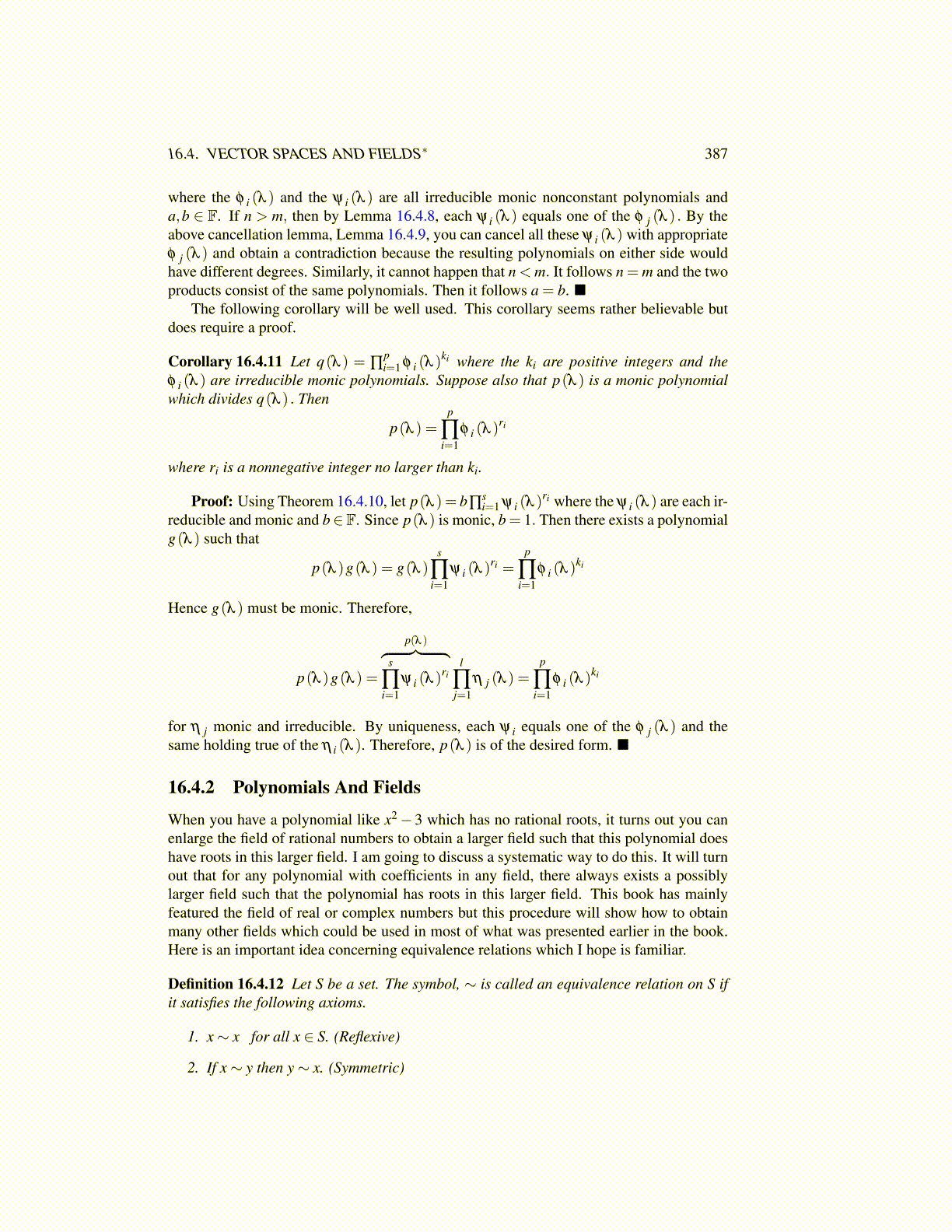
16.4. VECTOR SPACES AND FIELDS∗ 387
where the φ i (λ ) and the ψ i (λ ) are all irreducible monic nonconstant polynomials anda,b ∈ F. If n > m, then by Lemma 16.4.8, each ψ i (λ ) equals one of the φ j (λ ) . By theabove cancellation lemma, Lemma 16.4.9, you can cancel all these ψ i (λ ) with appropriateφ j (λ ) and obtain a contradiction because the resulting polynomials on either side wouldhave different degrees. Similarly, it cannot happen that n < m. It follows n = m and the twoproducts consist of the same polynomials. Then it follows a = b. ■
The following corollary will be well used. This corollary seems rather believable butdoes require a proof.
Corollary 16.4.11 Let q(λ ) = ∏pi=1 φ i (λ )
ki where the ki are positive integers and theφ i (λ ) are irreducible monic polynomials. Suppose also that p(λ ) is a monic polynomialwhich divides q(λ ) . Then
p(λ ) =p
∏i=1
φ i (λ )ri
where ri is a nonnegative integer no larger than ki.
Proof: Using Theorem 16.4.10, let p(λ ) = b∏si=1 ψ i (λ )
ri where the ψ i (λ ) are each ir-reducible and monic and b∈ F. Since p(λ ) is monic, b = 1. Then there exists a polynomialg(λ ) such that
p(λ )g(λ ) = g(λ )s
∏i=1
ψ i (λ )ri =
p
∏i=1
φ i (λ )ki
Hence g(λ ) must be monic. Therefore,
p(λ )g(λ ) =
p(λ )︷ ︸︸ ︷s
∏i=1
ψ i (λ )ri
l
∏j=1
η j (λ ) =p
∏i=1
φ i (λ )ki
for η j monic and irreducible. By uniqueness, each ψ i equals one of the φ j (λ ) and thesame holding true of the η i (λ ). Therefore, p(λ ) is of the desired form. ■
16.4.2 Polynomials And Fields
When you have a polynomial like x2− 3 which has no rational roots, it turns out you canenlarge the field of rational numbers to obtain a larger field such that this polynomial doeshave roots in this larger field. I am going to discuss a systematic way to do this. It will turnout that for any polynomial with coefficients in any field, there always exists a possiblylarger field such that the polynomial has roots in this larger field. This book has mainlyfeatured the field of real or complex numbers but this procedure will show how to obtainmany other fields which could be used in most of what was presented earlier in the book.Here is an important idea concerning equivalence relations which I hope is familiar.
Definition 16.4.12 Let S be a set. The symbol, ∼ is called an equivalence relation on S ifit satisfies the following axioms.
1. x∼ x for all x ∈ S. (Reflexive)
2. If x∼ y then y∼ x. (Symmetric)